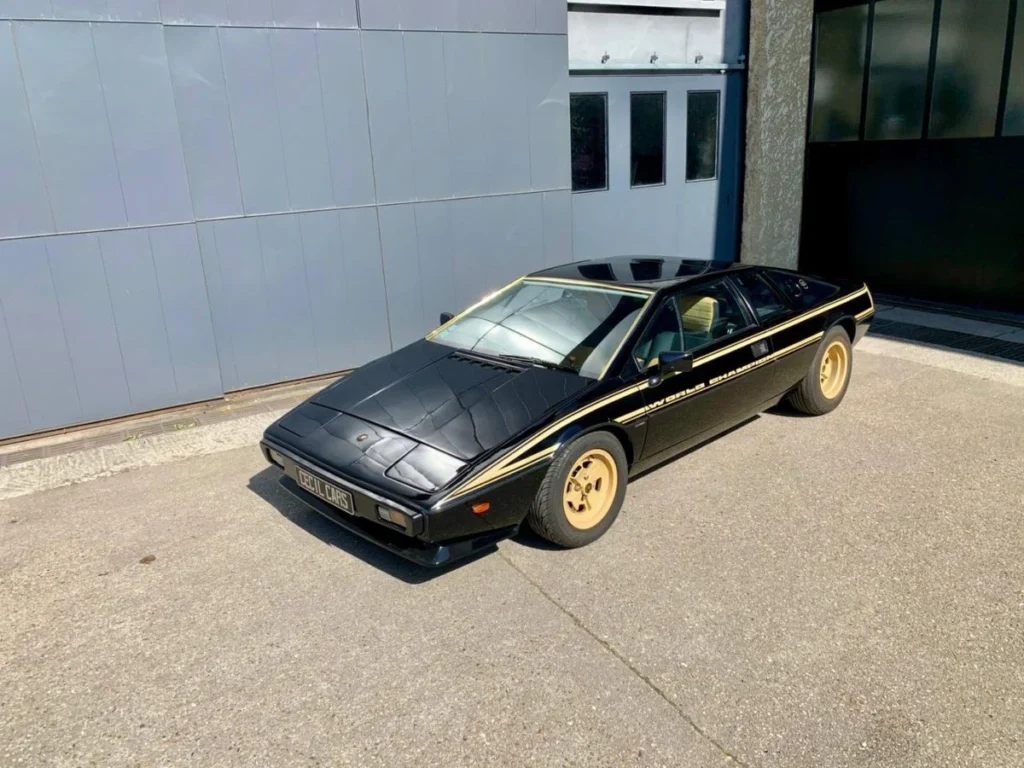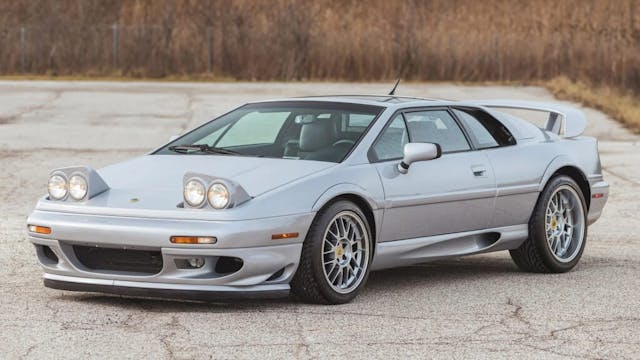Media | Articles
Half-Century d’Esprit: Which Lotus Wedge Is for You?
This year marks the official 50th anniversary of the Lotus Esprit. That’s despite the production version of the Giugiaro-penned wedge appearing in 1974 but not actually going on sale until 1976. Blame British eccentricity if you like, but what’s for sure is that there’ll be celebrations at Hethel and far beyond to mark this most iconic of Colin Chapman’s creations.
Is this lovely Lotus for you? Perhaps now is the time to put on your brave pants (as I did) and risk Esprit ownership.
Across a 28-year production period, there are plenty of great Esprit variants to choose from. More than 10,000 examples sold, too, and approximately a quarter of those were delivered to the U.S. after official imports of federalized cars began in 1983.
Esprits are old enough now (at least 25 years) that enthusiasts can import any model to the States (only 15 years for Canada), but which one of over 20 iterations would you pick?

S1
It’s said that Giorgetto Giugiaro thought the Esprit should be called the Kiwi, but Lotus bosses stuck to their guns and followed Hethel’s E-naming tradition like the Elite, Elan, and Europa before it. Produced from 1975 to 1978, the Series 1 Esprit was powered by the two-liter 16-valve, DOHC, 160-hp 907 engine. Lotus made 894 of them. It’s the S1 that 007 most famously drove into the ocean in the Bond film The Spy Who Loved Me, putting the Esprit on the map and helping make Series 1 cars among the most valuable. Hagerty values a Good-condition (#3) car at $32,100 with Concours-condition (#1, or best-in-the-world) examples estimated at $87,300.
Marketplace
Buy and sell classics with confidence

S2
In 1978, Lotus delivered the first major update to the Esprit in the form of the S2. Air management was the biggest change, with a new front spoiler and side intakes to feed the engine. Lotus incorporated tail lamps from the Rover 3500, plus Speedline alloy wheels, and the interior benefitted from wider seats along with revised instruments and switchgear. For an S2 in #3 condition, shoppers can expect to pay $23,600, or $50,800 for a #1 car. The 200 JPS (John Player Special) cars, painted in black with gold pinstriping to celebrate Lotus’s victory in the 1979 Formula 1 World Championship fetch a ten percent premium.

S2.2
Only 88 S2.2s were made between 1980 and 1981, but they’re significant because they introduced a new 2.2-liter version of the 907 engine. Along with the increased capacity came a lightened flywheel, uprated main bearing supports, new camshafts, and re-jetted Dell’Orto twin carbs. It was this engine that, for the first time, received forced induction in the ultra-rare Essex Turbo. With a Garrett T3 blower the Esprit now had 210 hp, plus bigger brakes and more aggressive styling from the pen of Giugiaro.
Only 45 were built—too rare for Hagerty to price—but recent sales suggest some Lotus fans are willing to pay close to $175,000. Despite the improvements, non-turbo Esprit S2.2s are valued almost exactly the same as the earlier S2s, with #3 cars at $24,600 and #1 examples at $50,000.

S3
The last of the G (for Giugiaro) cars, the 1981-1987 S3, was also dynamically the best. It received the chassis from the Essex for significantly improved torsional stiffness, plus some more interior upgrades including steering wheel, seats, and instruments. Externally, there were Turbo-style color-coded bumpers, side sills, and scoops. Two Turbo versions were offered: From 1981-1986, the Turbo Esprit was presented with the same 210 horses as the Essex, with engines in both dry- and wet-sump guise. There was better cooling from NACA ducts in the sills, and an all-important boost gauge on the dash.
Two Turbo Esprit featured briefly in another Bond flick, For Your Eyes Only. For its final year of production the Turbo HC (High Compression) was launched at the London Motor Show, with an extra five horses and more torque. Mahle forged pistons increased the compression ratio (hence the name), and Lotus used Nikasil for the liners. For an S3 Turbo in #3 (Good) condition, our experts say you’d be looking at $30,000 and over $65,000 for a car in the #1 Concours class. Normally aspirated cars are $21,600 and $44,700 in comparable condition.

Esprit
Known internally as the X180, the Series 4 Esprit got a major makeover at the hands of Peter Stevens. Although there was still no mistaking the profile, Giugiaro’s hard edges were softened and panel gaps closed. It was mechanically much the same as the outgoing Esprit, but the rear brakes were moved outboard, while the Citroën transmission was swapped for a Renault GTA unit (early federalized cars ultimately kept the Citroën unit). Sold from 1987-1990, normally aspirated cars didn’t make it to the U.S., and a Good-condition Turbo will likely cost $19,200, and a concours example runs to $61,900.

SE
Fuel injection and charge cooling made the 1989-1991 SE the most powerful Esprit to date, offering over 260 hp and a 160 mph top speed. Lotus made 563 of them, which put it second in terms of overall production numbers after the S1. A lower-powered S model was also offered, and the SE was followed by a High Wing version with an improved cabin for 1992. Only the Turbo SE was sold Stateside, and Lotus got more exceptional cinematic showings in Pretty Woman and Basic Instinct. Values range from $25,900 for a #3 Good Condition car to $56,400 for a #1 Concours version.

S4
1993 saw the next step in Esprit evolution with the S4, updating suspension, adding power steering, and refining the aerodynamics. Lotus took the Esprit racing with a car known as the X180R, and from it was derived the 300-hp 300 Sport. Between that and the standard S4 sat the S4S, running the 300-hp motor but with softer suspension settings of the base car. Of all the four-cylinder S4 models, however, the GT3 was perhaps the best balanced. It also gained the benefit of ABS brakes. Expect to pay $35,800 with a concours example coming at $80,100.

V-8
The ultimate Esprit arrived in 1996, packing a twin-turbo V-8 engine of Lotus design that truly put the model in the supercar league. Over 350 hp was available from the 3.5-liter engine. The extra grunt helped the Esprit achieve a sub-five-second 0-62 mph time along with a 175-mph top speed. Various versions, including a run of 50 350 editions and SEs, ushered out the Esprit’s twilight years in style. (Production finally ended in 2004.) Prices range from $41,600 for a car in #3 condition up to $140,000 for car that could compete in a concours.










The only one worth having was the V8 model.
Have you actually driven one of the earlier cars?
It’s largely misunderstood isn’t it.? That beautiful supercar shape that people expect some raucous 8 -12 cylinder has a little 4 banger. That completely ignores the fact that it is a featherweight and follows the Lotus philosophy that way. ‘ The Spy Who Loved Me ‘ submarine shown is the best thought of culture car version. As the Esprit is a true conniseurs item, more for those who if forced would pick Carol Boquet ( For Your Eyes Only ) as their favorite Bond girl following along those lines.
I loved the Peter Stevens facelift, made the car look less like a home built kit car (which, if you recall, how Lotus got started in street cars).
Living in the UK in the late ’80s, I encountered plenty being run by young guys whose enthusiasm outstripped their budgets. I guess there one theoretically COULD run one on a shoestring, but they’d have to be a better mechanic than me.
If I were in the UK and had a specialist shop nearby,.I’d be sorely tempted, here in the U.S., not so much.
I always like the car but I think design wise it looked better over time. The final V8 models are my favorite.
I was never a fan of true wedge-shape cars, so the earlier versions didn’t really appeal to me. Kinda Bricklin-like, really. As they became a bit more rounded over time, I softened my view of them. Oops, now I seem to be detouring off into thoughts of Bond Girls, so I’ll stop here…
I prefer the slimmer lightweight models but that’s me, to each his own. Live and let live _” But in this ever changing world we’re livin’… makes you give in and cry..say live and let die…
I had the opportunity to drive a Lotus Esprit V8 around Waterford Sports Car Circuit in Michigan – back in the late 1990’s…at a track day driving exotic sports cars. Needless to say, it was an awesome day, and the Lotus Esprit V8 turned out to be a favorite car of more than a few of us! The combination of its handling, power, driver ergonomics and gearbox made for a very fun car to drive hard on the track. If I was considering buying a Lotus Esprit – the V8 would be the one I’d choose…loved driving it!
The new Emira has Esprit DNA in it (as testified by Lotus).
As a former 2001 owner, it’s what got me into an Emira.
Easy answer.
The 1991 Esprit X180R….top of the heap, truly special, last production street car by any manufacturer sold in the US with a full roll cage from the factory. And only 20 built! Next step down in the hierarchy would be the Sport 300, which would be my second choice if I couldn’t have a X180R.
The X180R are off the radar to most people as they almost never come to market and there at least 3 that are still with the original owners. Several with 20+ ownership. Too bad, as more people should be able to experience these rare beasts.
Another feature of the S2 or S2.2 (don’t remember which one now) included a major upgrade to the rear suspension; the S1 using its Chapman Strut as the upper locating link which proved to be a weak point.